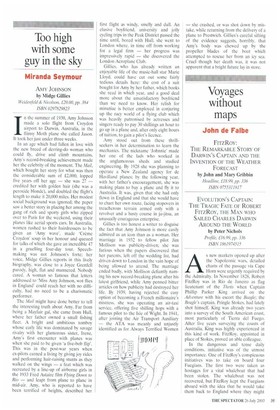Too high with some guy in the s
Miranda Seymour
AMY JOHNSON by Midge Gillies Weide*ld & Nicolson, £20.00, pp. 384 ISBN 0297829823 1 n the summer of 1930, Amy Johnson made a solo flight from Croydon airport to Darwin. Australia, in the flimsy Moth plane she called Jason. It took her just under three weeks.
In an age which had fallen in love with the new breed of derring-do woman who could fly, drive and climb mountains, Amy's record-breaking achievement made her the celebrity of the moment. The Mail, which bought her story for what was then the considerable sum of £2,000. lopped five years off her age — she was 27 — credited her with golden hair (she was a peroxide blonde), and doubled the flight's length to make it 20,000 miles. Her modest social background was ignored; the paper saw a better story in placing her among the gang of rich and sporty girls who zipped over to Paris for the weekend, using their planes like aerial sports cars. In Australia, women rushed to their hairdressers to be given an 'Amy wave', made 'Crème Croydon' soup in her honour and queued for talks of which she gave an incredible 47 in a gruelling four-day tour. Speechmaking was not Johnson's forte: her voice. Midge Gillies reports in this lively biography. was close to a Joyce Grenfell parody. high, flat and mannered. Nobody cared. A woman so famous that letters addressed to 'Miss Amy Johnson, wot flies in England' could reach her with no difficulty, had no need to be a charismatic performer.
The Mail might have done better to tell the interesting truth about Amy. Far from being a Mayfair gal, she came from Hull, where her father owned a small fishing fleet. A bright and ambitious tomboy whose early life was dominated by savage rivalry with her glamorous sister, Irene, Amy's first encounter with planes was when she paid to be given 'a five-bob flip'. This was in the post-war years when ex-pilots earned a living by giving joy rides and performing hair-raising stunts as they walked on the wings — a feat which was recreated by a line-up of airborne girls in the 1933 Fred Astaire film Flying Down to Rio — and leapt from plane to plane in mid-air. Amy, who is reported to have been terrified of heights, described her
first flight as windy, smelly and dull. An elusive boyfriend, university and jolly cycling trips in the Peak District passed the time until, bored with Hull, she went to London where, in time off from working for a legal firm — her progress was impressively rapid — she discovered the London Aeroplane Club.
Gillies, who has already written an enjoyable life of the music-hall star Marie Lloyd, could have cut out some fairly tedious details here: the cost of a suit bought for Amy by her father, which books she read in which year, and a good deal more about the unsatisfactory boyfriend than we need to know. Her relish for minutiae is better employed in conjuring up the racy world of a flying club which was heavily patronised by actresses and singers ready to pay 30 shillings an hour to go up in a plane and, after only eight hours of tuition, to gain a pilot's licence.
Amy stood out from these thrillseekers in her determination to learn the mechanics. The nickname 'Johnnie' made her one of the lads who worked in the unglamorous sheds and studied engineering. By 1928 she was planning to operate a New Zealand agency for de Havilland planes; by the following year, with her father's encouragement, she was making plans to buy a plane and fly it to Australia. It was, given that she had only flown in England and that she would have to chart her own route, facing stopovers in treacherous terrain armed only with a revolver and a hasty course in ju-jitsu, an unusually courageous enterprise.
Gillies is too honest a writer to disguise the fact that Amy Johnson is more easily admired as an icon than as a woman. Her marriage in 1932 to fellow pilot Jim Mollison was publicity-driven; she was furious when the papers discovered that her parents, left off the wedding list, had driven down to London in the vain hope of being allowed to attend. The marriage ended badly, with Mollison defiantly naming his new record-breaking plane after his latest girlfriend, while Amy penned bitter articles on how publicity had destroyed her life. By 1939, having rejected the easy option of becoming a French millionaire's mistress, she was operating an air-taxi service, offering five shilling hops with a famous pilot to the Isle of Wight. In 1941, after joining the Air Transport Auxiliary — the ATA was meanly and unjustly identified as for Always Terrified Women — she crashed, or was shot down by mistake, while returning from the delivery of a plane to Prestwich. Gillies's careful sifting of the evidence suggests, horribly, that Amy's body was chewed up by the propeller blades of the boat which attempted to rescue her from an icy sea. Cruel though her death was, it was not apparent that a bright future lay in store.


























































 Previous page
Previous page